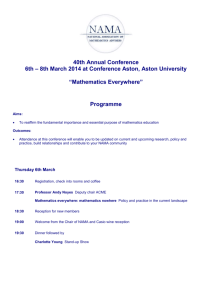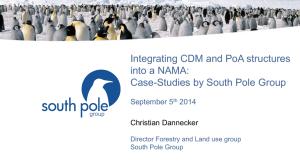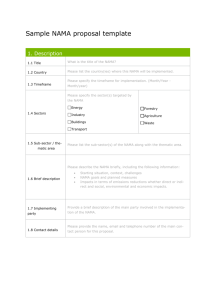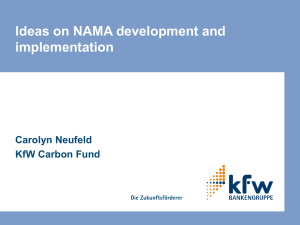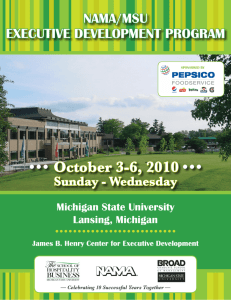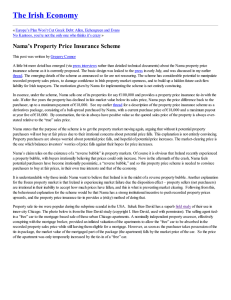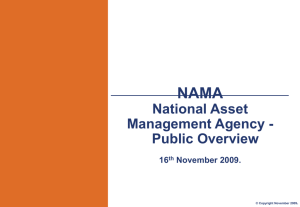Development of Integrated Solid Waste Management NAMA in
advertisement
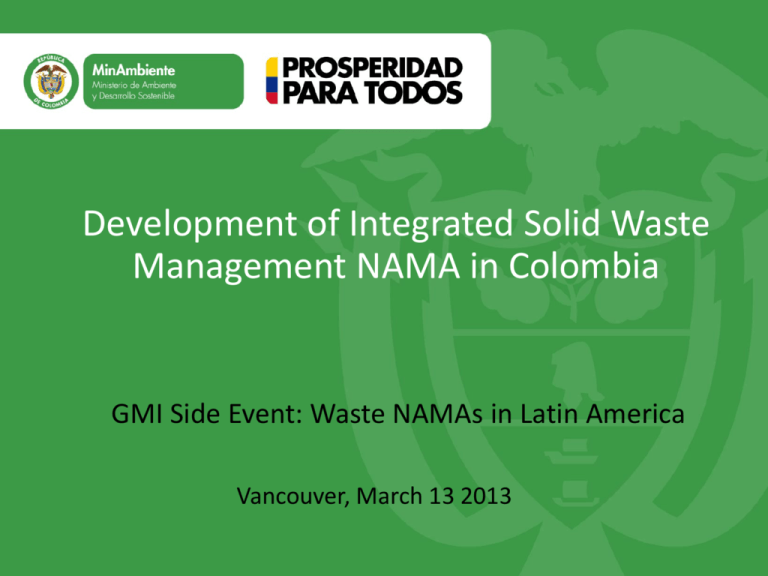
Título Subtítulo o texto necesario Development of Integrated Solid Waste Management NAMA in Colombia GMI Side Event: Waste NAMAs in Latin America Vancouver, March 13 2013 Contents 1. Colombian ISWM NAMA Development Process 2. Phase I “Scoping Study” 3. Draft NAMA 4. Phase II “Designing a comprehensive NAMA” 5. Preliminary results 6. Bringing to finish line 7. Lessons Learned and Conclusions 8. Questions? CCAP 2 Colombian ISWM NAMA development process Cooperation funding from Environment Canada. Launch (March 2012): • Organized sector-wide workshop March 2012 & formed Steering Committee with national government entities to guide NAMA development process. Colombian ISWM NAMA development process Cooperation funding from Environment Canada. Launch (March 2012): • Organized sector-wide workshop March 2012 & formed Steering Committee with national government entities to guide NAMA development process. Phase 1: “Scoping Study” (April 2012 – September 2012) • CCAP ranked various technologies. • economic feasibility and abatement potential. • Identification of those viable in Colombian context. • Barriers were identified. Phase 2: “Comprehensive NAMA design approach” (October 2012 – March 2013) • CCAP and consultants performed 6 studies to provide in-depth analytical foundation for NAMA design. Phase I: “Scoping study” (I) CCAP organized workshop in October 2012: present to the Steering Committee results of the “scoping study”. Steering Committee eliminated technologies such as incinerators and biodigestors. Steering Committee chose technologies for second phase: • Mechanical-Biological Treatment (MBT) Production of Refuse-derived Fuel (RDF). Production of compost or recyclables. • Biogas-to-energy. Phase I: “Scoping study” (II) Barriers identified: • outdated regulations (lack of incentives and policy measures), • lack of feasibility studies, • uncertainty and weakness in recyclables market, • challenges in formalizing informal waste collectors. Phase I: Colombian solid waste sector - lessons learnt. (I) High amount (94%) of MSW being successfully sent to sanitary LFs. Well developed private sector presence in MSW management. Phase I: Colombian solid waste sector - lessons learnt. (I) High amount (94%) of MSW being successfully sent to sanitary LFs. Well developed private sector presence in MSW management. Solid waste operators are paid using nationally set tariff rules which are skewed towards promoting LFs. Currently tariff rules allow for paying for recycling activities limited to collection and transport of recyclables and not for treatment or transformative technologies. Phase I: Colombian solid waste sector - lessons learnt. (II) The Colombian supreme court has instructed city and national government to recognize role of informal sector in MSW management. Increasing public awareness about environmental impacts of LFs and GHGs creates opportunity for ISWM NAMA. Draft NAMA considered after Phase I The Government of Colombia will aim to reduce __% through unilateral actions and up to ___% through supported actions by 2020 from its solid waste sector by undertaking integrated solid waste management programs that could include actions such • as diverting organics from landfills (thereby reducing methane emissions as part of landfill gas), • increasing recycling (thereby reducing indirect emissions by avoided production of recyclable material), • compost usage (leading to less use of artificial fertilizers), • generating refuse-derived fuel (thereby displacing conventional fossil fuel use) and • alternative uses of landfill gas. Emission reduction targets and timeline Actions that lead to direct or indirect reductions emission from a baseline activity/process Draft NAMA considered after Phase I • To implement these unilateral actions, the Colombian is requesting the international contributing community up to $___ Mn in the form of grants, concessional loans, credit guarantees and technology transfer in order to meet the supported NAMA target. Indication of NAMA financing required from supporting countries • The average $ per ton of CO2e spent on supported measures will be approximately $___/CO2e. Indicator of cost of achieving emission reduction Phase II “Comprehensive NAMA design”: List of studies Study Objective Regulatory reform Amend existing regulations to encourage next generation waste management technologies Suggest new regulations to encourage recycling, use of RDF and compost etc. Feasibility studies for MBT and LFG-to-energy projects [Cali & Barranquilla] To analyze economic cost of selected technologies to design appropriate tariffs and for design financing structures Study of recyclables and compost markets To identify growth opportunities and policy recommendations for strengthening of markets Study for formulating strategies for formalizing informal sector To identify job creation and sector formalization opportunities in NAMA NAMA financial structure To provide pvt. sector and multilateral finance institutions with investment opportunities Preliminary results – Regulatory reform The Steering Committee has made a joint submission to the government requesting for inclusion of technologies such as MBT facilities as technologies eligible for receiving tariffs • Currently submission is being made for tariff authority that develops a methodology for ascribing tariffs to management technologies apart from LFs Such modifications should be made during 2013 there creating a level playing field between LF and other tech Further technical studies are required to write regulations about technical standards and monitoring of such technologies Preliminary results – MBT feasibility study MBT facilities when receiving large quantities of waste and have an anchor client for RDF have a viable business model For e.g Analysis for Cali shows following results (Only recyclable revenue from aluminum and steel cans) Results show that such a facility can compete with LFs for the city and be a cheaper fuel source for industry Preliminary results – Market study Market study • Recycling through informal and formal sector is quite high for commodities such as paper, cardboard and metals. • Growth for above sectors will be linked to overall GDP growth • Greater potential exists for glass and plastics but such growth depends on availability of technologies for converting plastic in to pellets etc. • Govt. could focus on export of recyclable material and creating markets through regulation for commodities such as RDF and compost Título Subtítulo o texto necesario Thank you Diana M. Rodríguez Ministry of Environment and Sustainable Development Climate Change Division dmrodriguez@minambiente.gov.co www.ccap.org
